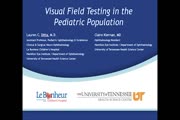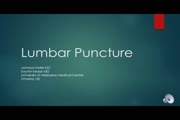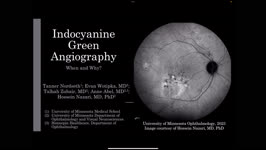Collection of materials relating to neuro-ophthalmology as part of the Neuro-Ophthalmology Virtual Education Library.
NOVEL: https://novel.utah.edu/
TO
- NOVEL229
| Title | Creator | Description | Subject | ||
|---|---|---|---|---|---|
| 26 |
 |
Vertical optokinetic nystagmus | Anat Bachar Zipori, MD; Nasrin Najm-Tehrani, FRCS Ed (Ophth), FRCSC | Visual depiction of the vertical OKN drum test. The vertical optokinetic drum test is an exam used to elicit vertical optokinetic nystagmus (OKN) when there is horizontal nystagmus. The hand-held "optokinetic" drums or tapes that are used to elicit smooth movements primarily test the pursuit system.... | Vertical Optokinetic Nystagmus; OKN Drum Test |
| 27 |
 |
Horizontal Right Optokinetic Nystagmus | Anat Bachar Zipori, MD; Nasrin Najm-Tehrani, FRCS Ed (Ophth), FRCSC | Visual depiction of the horizontal OKN drum test. The hand-held "optokinetic" drums or tapes that are used to elicit smooth movements primarily test the pursuit system. This video supplements Paediatric Neuro-ophthalmology: Visual Acuity Assessment Strategies: https://collections.lib.utah.edu/ark:/... | Horizontal Right Optokinetic Nystagmus; OKN Drum Test |
| 28 |
 |
Visual Field Testing in the Pediatric Population | Lauren C. Ditta, MD | Visual field testing can be performed in the pediatric population with ease, however the proper technique for testing must be utilized and is tailored to each child's unique clinical situation and age. Confrontation visual field testing is a quick and easy; test that can yield a rough assessment of ... | Visual Field Testing; Pediatric; Confrontation Visual Field; Automated; Perimetry |
| 29 |
 |
Introduction to Evaluation in Special Situations in NANOS NOTE | John Pula, MD | An introduction to NOTE sections on Examination of the Comatose Patient and Examination of the Pediatric Patient. | Patient Examination; Pediatric Patient; Examination |
| 30 |
 |
Introduction to Examination of the Pediatric Patient | Jason H. Peragallo, MD | Introduction to examination of the pediatric patient. | Pediatric Patient |
| 31 |
 |
Introduction to Diagnostic Testing: Audio-Vestibular | Daniel R. Gold, DO | Introduction to the audio-vestibular diagnostic testing section of the NExT curriculum. | Diagnostic Testing; Exams; Audio-Vestibular |
| 32 |
 |
Lumbar Puncture | Jamison Hofer, DO; Sachin Kedar, MD | Explanation of lumbar puncture procedure. | Lumbar Puncture |
| 33 |
 |
Introduction to the Neurological Examination in NANOS NOTE | Padmaja Sudhakar, MD | An introduction to the neurological examination. | Neurology; Neurological Examination |
| 34 |
 |
Examination of Lymph Nodes | John D. Ng, MD, MS, FACS | Demonstration of lymph node examination. | Exam; Lymph Nodes |
| 35 |
 |
Introduction to Examination of Eye Movements and Alignment in NANOS NOTE | Jason H. Peragallo, MD | Introduction to Examination of Eye Movements and Alignment | Eye Movement; Alignment; Examination |
| 36 |
 |
Introduction to Examination of the Vestibular System | Daniel R. Gold, DO | Introduction to the Vestibular System Examination section of the NExT curriculum. | Exams; Vestibular System |
| 37 |
 |
Visual Fields Part 2: Interpreting The Test Results | Jonathan Trobe, MD | Discussion of interpreting the results of visual field testing. | Visual Fields |
| 38 |
 |
Visual Fields Part 1: Performing The Tests | Jonathan Trobe, MD | Discussion and demonstration of visual field testing. | Visual Fields |
| 39 |
 |
Double Simultaneous Visual Field Stimulation | Victoria S. Pelak, MD; James R. Bateman, MD, MPH; Brianne Bettcher, PhD | Explanation of the double simultaneous visual field exam, as part of the larger higher order visual function examination. Video accompanies The Clinical Examination of Higher Order Visual Function: Syndrome-based Approach: https://collections.lib.utah.edu/ark:/87278/s6837zqp and Visual Neglect: http... | Visual Function; Visual Fields |
| 40 |
 |
Executive Function | James R. Bateman, MD, MPH; Victoria S. Pelak, MD | Introduction to the executive function exam as part of the larger mental status examination. Video accompanies the The Mental Status Examination lecture at https://collections.lib.utah.edu/ark:/87278/s64b7716 and Cognitive Assessment at: https://collections.lib.utah.edu/ark:/87278/s6qc49rx | Mental Status |
| 41 |
 |
Ideomotor Apraxia | James R. Bateman, MD, MPH; Victoria S. Pelak, MD | Introduction to the ideomotor apraxia exam as part of the larger mental status examination. Video accompanies the The Mental Status Examination lecture at https://collections.lib.utah.edu/ark:/87278/s64b7716 and Cognitive Assessment at: https://collections.lib.utah.edu/ark:/87278/s6qc49rx | Mental Status |
| 42 |
 |
Limb-Kinetic Apraxia | James R. Bateman, MD, MPH; Victoria S. Pelak, MD | Introduction to the limb kinetic apraxia exam as part of the larger mental status examination. Video accompanies the The Mental Status Examination lecture at https://collections.lib.utah.edu/ark:/87278/s64b7716 and Cognitive Assessment at: https://collections.lib.utah.edu/ark:/87278/s6qc49rx | Mental Status |
| 43 |
 |
Nerve Conduction Studies and Electromyography Basics | Jamison Hofer, DO; Kiel Woodward, MD; Ezequiel Piccione, MD; Sachin Kedar, MBBS, MD | Presentation covering an overview of the basics of nerve conduction studies and electromyography. Includes coverage of common indications, limitations and contraindications. There is an explanation for how to order the test, and how to understand the results. | Nerve Conduction Studies; Electromyography; NCS; EMG |
| 44 |
 |
Coordination Exam: Abnormal Examples: Heel-to-shin (x2) (includes Spanish audio & captions) | Paul D. Larsen, MD | The patient with ataxia of the lower extremity will have difficulty placing the heel on the knee with a side-to-side irregular over- and undershooting as the heel is advanced down the shin. Dysmetria on heel-to-shin can be seen in midline ataxia syndromes as well as cerebellar hemisphere disease so ... | Coordination Examination; Heel-shin Test |
| 45 |
 |
Coordination Exam: Normal Exam: Finger-to-nose (includes Spanish audio & captions) | Paul D. Larsen, MD | The patient moves her pointer finger from her nose to the examiner's finger as the examiner moves his finger to new positions and tests accuracy at the furthest outreach of the arm. NeuroLogic Exam has been supported by a grant from the Slice of Life Development Fund at the University of Utah, the D... | Coordination Examination; Finger-to-nose Test |
| 46 |
 |
Coordination Exam: Abnormal Examples: Finger-to-nose (x2) (includes Spanish audio & captions) | Paul D. Larsen, MD | The patient places her heel on the opposite knee then runs the heel down the shin to the ankle and back to the knee in a smooth coordinated fashion. NeuroLogic Exam has been supported by a grant from the Slice of Life Development Fund at the University of Utah, the Department of Pediatrics and the O... | Coordination Examination; Finger-to-nose Test |
| 47 |
 |
Coordination Exam: Normal Exam: Heel-to-shin (includes Spanish audio & captions) | Paul D. Larsen, MD | The patient places her heel on the opposite knee then runs the heel down the shin to the ankle and back to the knee in a smooth coordinated fashion. NeuroLogic Exam has been supported by a grant from the Slice of Life Development Fund at the University of Utah, the Department of Pediatrics and the O... | Coordination Examination; Heel-shin Test |
| 48 |
 |
Introduction to Diagnostic Tests in NANOS NOTE | Amanda D. Henderson, MD | An introduction to Diagnostic Tests | Diagnostic Testing |
| 49 |
 |
Idocyanine Green Angiography | Tanner Nordseth; Evan Wotipka; Talhah Zubair; Anne Abel; Hossein Nazari | This narrated PowerPoint presentation gives an overview of idocyanine green angiography. Historical significance, diagnostic utility, and comparison to fluorescein angiography are discussed. | Angiography; Choroidal imaging; Idocyanine green |
| 50 |
 |
Basic Eyelid Measurements | John D. Ng, MD, MS, FACS | Demonstration of basic eyelid measurements. | Eyelid |
